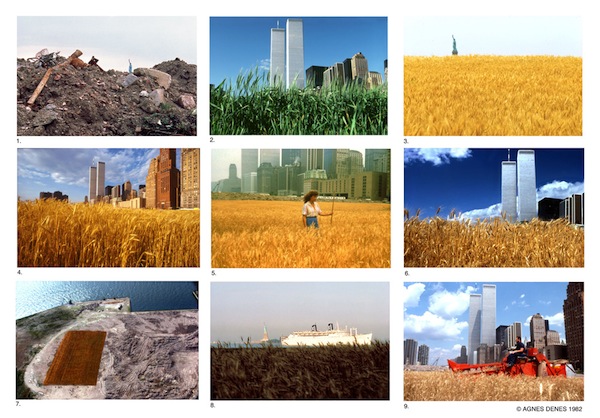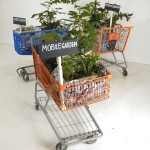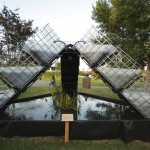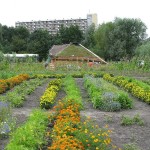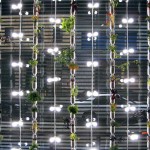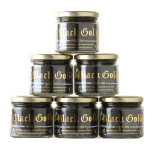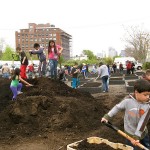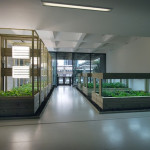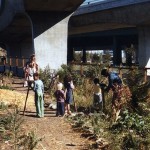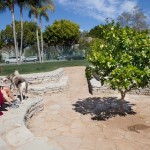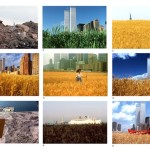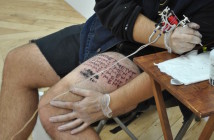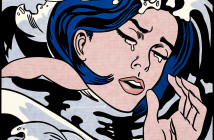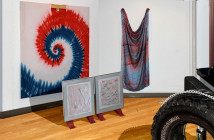For four months, a windswept field of golden wheat grew on a two-acre parcel of land atop the Battery Park City landfill in lower Manhattan. The Statue of Liberty, the World Trade Center, and Wall Street stood nearby. When harvest time arrived, the wheat—1,000 pounds of it—was reaped and later sent to 28 points across the globe to be displayed in The International Art Show for the End of World Hunger and planted as a symbolic gesture. It was the summer of 1982, and artist Agnes Denes wanted to make a statement on the "misplaced priorities" of modern society through her now-famous installation Wheatfield—A Confrontation. She was 30 years ahead of what has in the last decade become widespread: artists cultivating edible crops as part of their practice.1
"It is no surprise that farming, gardening, food production, and eating itself have become more common among artists’ concerns," says Amy Lipton, director of the New York branch of Ecoartspace, a bicoastal organization that promotes environmental art through curatorial projects and lectures. "Food prices, industrial agriculture, monoculture in farming, and bioengineering are all on the rise and becoming larger problems," she adds.
In 2002, Lipton and curator Sue Spaid put together the landmark exhibition EcoVention for the Contemporary Arts Center in Cincinnati.
 Didier Hess, Food Pyramid in EATLACMA, Los Angeles County Museum of Art, 2010-2011.
Didier Hess, Food Pyramid in EATLACMA, Los Angeles County Museum of Art, 2010-2011.Courtesy of Fallen Fruit.
Among the early agricultural projects championed in the show was Denes’s pioneering eco-installation Rice/Tree/Burial for which she planted a rice field, chained trees together, and buried her own poetry in Sullivan County, New York, in 1968, and again at Artpark in Niagara County, New York, in 1977. In those nascent years of agricultural art, works like Denes’s were often dismissed as "science, not art," Spaid recounts. But today more and more art institutions are turning their galleries and surrounding soil into edible gardens and farms, fostering works of art that literally take root and sprout up before the public.
"Food is an urgent topic," says José Luis Blondet, associate curator of special programming at the Los Angeles County Museum of Art. LACMA set new precedent in 2010 by devoting an entire year to EATLACMA, a three-part multimedia examination of food developed in collaboration with the art collective Fallen Fruit (David Burns, Austin Young, and Matias Viegener). Among the EATLACMA projects were a variety of artist-designed gardens planted on museum grounds. Lauren Bon and Metabolic Studio erected a hospital-like intensive care unit to nurse "sick" strawberries, rescued from industrial farms, back to health. And a pyramid-shaped aquaponics system by Didier Hess grew all of the necessary ingredients for fish tacos. "These gardens were not exceptionally beautiful and were in no way how one would imagine ‘museum gardens’ to look," said Blondet. "They served as a reminder of what a garden should, could, or would be in a bright future." Fallen Fruit’s David Burns offers another point of view: "The gardens were also about how the public interacts with something that’s growing." For their EATLACMA piece Public Fruit Theater, Fallen Fruit and La Loma Development planted a single orange tree in the center of a small amphitheater made of reclaimed chunks of sidewalk. Visitors could sit and watch the tree "perform" its seasonal growth cycles between November 2010 and April 2011—and then eat the oranges that fell from its branches.
California’s paradisiacal landscape has also been the setting for important works by veteran performance artist and environmental activist Bonnie Ora Sherk. Her ambitious project Community Crossroads (The Farm) (1974-1980) transformed seven acres of land beneath San Francisco’s Highway 101 into creative and educational commons. Here, one could find art troupes and local residents caring for vegetables, fruit trees, chickens, and goats.2 The Farm was the coming together of interests expressed in Sherk’s earlier pop-up series Portable Parks I-III (1970) for which she dropped patches of lawn, picnic tables, and live animals onto unexpected public sites. In January 2012, Sherk revisited this series for The Getty’s much-applauded survey Pacific Standard Time. Public Park IV—a temporary edible garden—was installed at the center of a Los Angeles County mall.
The detachment of many Americans from food production became a banner issue earlier this century with the publication of popular books like Eric Schlosser’s Fast Food Nation (2000) and Michael Pollan’s The Omnivore’s Dilemma (2006). Raphaela Platow, the director and chief curator at Cincinnati’s Contemporary Arts Center, says that a desire to reconnect the public with agricultural practices is another reason more artists are cultivating food themselves. "Artists can help us to be more aware of where we are as human beings. Food production is so incredibly industrialized by now, we have no clue where our food is from, how it’s processed, how it gets on our plate. By planting food, you can bring awareness again into what it means to nourish yourself." In September, the CAC opened Green Acres: Artists Farming Fields, Greenhouses and Abandoned Lots, the first museum exhibition entirely devoted to farming as a form of art and activism. Spaid returned to the museum as guest curator for the show.
Green Acres brings together 24 artists of different generations. Their works are divided between the galleries and select public spaces. One of the earliest works on view is a refabrication of Newton and Helen Harrison’s Survival Series, a completely operational indoor farm originally made in the early ‘70s. Long before "sustainability" and "green" became buzzwords, the Harrisons were exploring self-sufficient food practices and inviting art goers to partake in the outcome, which included brine shrimp, catfish, pigs, potatoes, leafy green vegetables, and citrus fruits. "The people in Green Acres are rethinking farming in provocative ways that farmers or ordinary people with gardens don’t do," says Spaid. "One of the things that artists do best is come up with novel solutions to things that eventually become conventional practices."
Artists’ objectives for growing food vary as much as the crops they produce but almost all have one commonality: the urban environment. Gone are the days of Grant Wood’s American Gothic (1930), when farmers in art signified rural agrarian life. Artists today are cultivating foodstuffs in and for major cities. "Gardening for edible purposes is going to become even more important and necessary in urban centers, and for cities to become more self-sustaining," says Lipton. "Artists are always at the forefront, and have an early awareness of impending crises." Enter the obesity epidemic, one of America’s most pressing societal health problems today. Artist Lisa Gross counts creating healthier communities among her goals for The Boston Tree Party, which launched in April 2011. Both a conceptual art project and collaborative campaign, Gross’s venture has planted over 100 heirloom apple tress across greater Boston. She names the German theorist and social practice artist Joseph Beuys (1921-1986) as an influence. Interestingly, as Gross observes, the recent growth of social practice art has coincided with the good food movement and larger cultural interest in eating healthfully and sustainably. "So much of that dialogue is about community impact," Gross says. "It makes sense to me that social practice would intersect with this moment in food." To date, 72 different communities are participants in The Boston Tree Party. Although the project concludes in fall 2015, marking their first full apple harvest, the trees will feed Bostonians for decades.
"Growing food in the urban environment makes it more interesting," says New York-based artist Tattfoo Tan, whose practice includes "social sculpture" and what some call relational esthetics. "You also cut down on the shipment of food, so it makes sense for a greener world." In 2009, Tan began growing food under the umbrella title "S.O.S." (Sustainable Organic Stewardship) and has since exhibited everything from jarred "luxury" compost to mobile gardens in shopping carts. His multimedia compost installation Black Gold is included in Green Acres. Showing audiences "just how hard it is to grow food that you can consume" and allowing viewers to "get their hands dirty" are central to Tan’s work. The artist has hosted workshops for The Laundromat Project and Eyebeam Art + Technology Center, both in New York. Eyebeam is another institution that had, at one point, turned their attention to the art of growing food in urban spaces. Their Food in the City initiative, supported through educational and residency programs, was inspired in part by former artists-in-residence Britta Riley, creator of the hydroponic gardening kits Windowfarms, and Leah Gauthier, whose yearlong micro-farming project Sharecropper (2009) raised heirloom crops on donated lots across the five boroughs of New York City. Gauthier’s latest project takes the form of a limited-edition strawberry called The Marshall (2012). This high-quality fruit was discovered just outside of Boston in the late 1800s and though once popular is now considered "endangered." Gauthier aims to revive the strawberry by selling it to "collectors" within the U.S.
Los Angeles-based Burns, who travels widely planting and studying food with Fallen Fruit, speculates that the rise of artists-as-cultivators might be a "global" phenomenon. Certainly the trend is thriving in Europe. For the past seven years, "guerilla gardener" Richard Reynolds has been "pimping pavement" and "throwing seedbombs" in a graffiti-style approach to planting herbs and other crops on the streets of London. He travels the world lecturing about his practice and also making short films for his YouTube channel. The latest one was shot on the occasion of the 13th Venice Biennale, where guerilla gardening was highlighted in the architecture exhibition Common Ground.
In the Netherlands, the Stroom Den Haag Foundation launched Foodprint Program, a three-year investigation of urban food production, which began in 2009. The program commissioned artists to sow edible art throughout The Hague, the country’s third largest city. Amsterdam-based Debra Solomon says, "Stroom made real changes to the city and connected a lot of things that weren’t connected." Solomon’s Foodprint contribution Foodscape Schilderswijk has provided The Hague with a bounty of fresh consumables, as has Edible Park, another Foodprint commission, by English artist Nils Norman.
In its first harvest of the year, Norman’s two permaculture gardens yielded almost 90 different varieties of fruits, vegetables, nuts, berries, and herbs. Both artists’ gardens remained active through the end of 2011. Stroom wrapped up Foodprint Program with a courtroom-style "verbal battle" between experts in the fields of retail, science, culture, politics and agrofood. Their topic of debate? How to feed our cities in the future.
No longer is the question, as it once was, how does growing edible crops qualify as an art worthy of display? But rather, why are these practices so prevalent now and what do they tell us about the human condition? There’s no one answer to this but with food related illnesses, environmental disasters, and mass food contaminations frequently making news headlines, maybe it’s no wonder that we are seeing this type of work flourish. Also consider this: urban agriculture taps into leading themes of the zeitgeist including foodie culture, small-batch and artisan production, DIYism, and even social media technologies, where the implication is that everyone can have a direct hand in changing things, and making a difference in how society functions.3 Through innovative food systems, artists are helping publics to envision better, healthier times ahead. Of course, art has always been a catalyst for shifting how we think about tomorrow’s possibilities.
No one can be certain whether edible gardening and farming among artists and institutions is a passing trend or part of an ongoing movement that aims to change our relationship to the foods we eat—permanently. We can at least be sure of one thing that Tan says: "It’s a sign of our time."
- Tattfoo Tan, Mobile Gardens, 2009-ongoing. Plants, found and recycle materials. Courtesy of the artist.
- Didier Hess, Food Pyramid in EATLACMA, Los Angeles County Museum of Art, 2010-2011. Courtesy of Fallen Fruit.
- Nils Norman, Edible Park, 2011. Photo: courtesy Stroom Den Haag.
- Britta Riley, Windowfarms installed at Eyebeam Art + Technology Center, 2009. Courtesy of Windowfarms.
- Tattfoo Tan, Black Gold, 2009-ongoing. Compost, glass jar, safe. Courtesy of the artist.
- Lisa Gross, The Boston Tree Party, East Boston Neighborhood Health Center: Let’s Get Moving Program. Courtesy of the artist.
- Harrison Studio, Survival Series #6, 1973/2012. Now on view at the Contemporary Art Center, Cincinnati. Shown here installed at Barbican Art Gallery, London, 2009. Photo: Lyndon Douglas.
- Bonnie Ora Sherk, Community Crossroads (The Farm), 1974-1980. Photo: Vicky Pollack.
- Fallen Fruit Collective, Public Fruit Theater in EATLACMA, Los Angeles County Museum of Art, 2010-2011. Photo: Fallen Fruit.
- Agnes Denes, Wheatfield—A Confrontation, 1982. © Agnes Denes.
[1] This article is by no means comprehensive. The number of artists who are cultivating edible crops as part of their practice is far greater than could be covered here. Sue Spaid affirms this with her exhibition Green Acres, which displays works by 24 artists while nearly 70 are covered in the accompanying catalogue.
[2] According to cultural critic Lucy Lippard, Community Crossroads was one of the most important ecological art projects in the United States. See quote in Bonnie Sherk’s "Interactive Living Library of Cultural and Ecological Diversity." http://www.alivinglibrary.org/articles/interactive.html
[3] See Sarah Rich’s "Urban Farms," Abrams, New York. 2012; and Caruth’s "Tweet Cuisine, A Recipe for Disaster," C Magazine, Summer 2011, 30-33.

